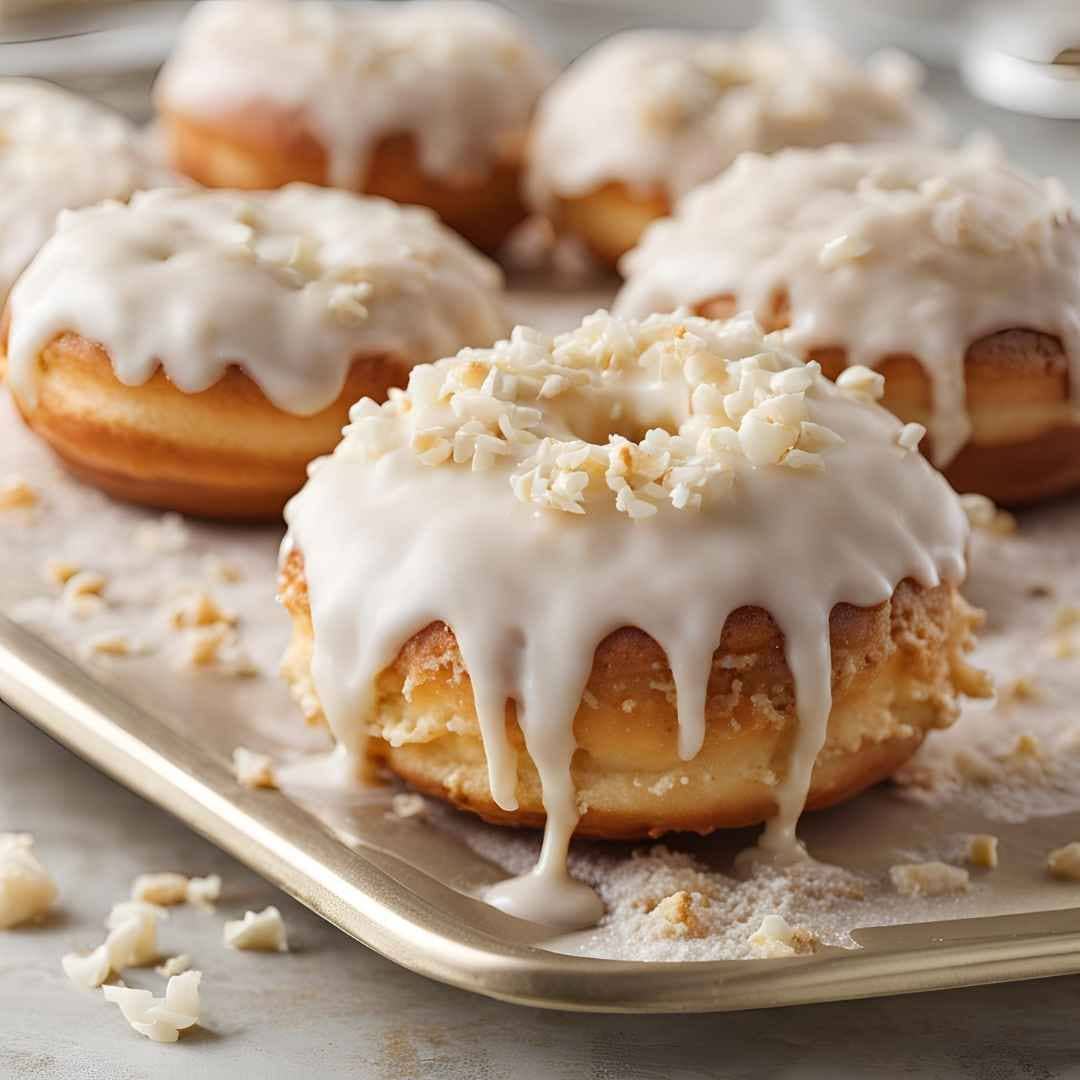Italian cream-filled donuts, also known as “bomboloni,” are a classic treat that combines a soft, pillowy dough with a rich, creamy filling. Originating in Italy, these delicious pastries are enjoyed throughout the day, whether as a breakfast indulgence, a mid-afternoon snack, or a decadent dessert. With their golden exterior, dusted with sugar, and luscious filling that oozes out with every bite, they are a testament to the rich culinary traditions of Italian bakeries and patisseries. Loved by people of all ages, these donuts bring a touch of elegance and comfort to any occasion.
The History of Bomboloni
Bomboloni’s roots can be traced back to Tuscany, a region renowned for its simple yet exquisite culinary creations. Traditionally fried in olive oil and filled with custard or jam, bomboloni have evolved over the years to include a wide array of fillings and variations. They were originally enjoyed by farmers and laborers as a high-energy snack during the day. Over time, the popularity of these donuts spread across Italy and eventually to other parts of the world. Today, they are celebrated as a symbol of Italian culinary artistry, cherished for their balance of textures and flavors. The name “bomboloni” comes from the Italian word “bomba,” meaning bomb, referring to their round shape and the explosion of flavor they deliver with each bite.
Ingredients Breakdown
To create these delightful donuts, you will need a combination of basic pantry staples and a few specialty items. The dough is made with all-purpose flour, sugar, eggs, yeast, milk, and butter. These ingredients come together to form a soft, pliable dough that is slightly sweet and perfect for frying. The filling is typically a creamy custard made from egg yolks, sugar, milk, and vanilla, but variations include pastry cream, Nutella, jam, or ricotta cheese mixed with sugar and zest. Additionally, a touch of salt enhances the flavor, while a dusting of granulated sugar or powdered sugar provides the perfect finishing touch. Each ingredient plays a crucial role, from the yeast that helps the dough rise to the butter that adds richness and depth to the final product.
Step-by-Step Recipe
- Prepare the Dough: Begin by dissolving the yeast in warm milk along with a teaspoon of sugar. Let it sit for 5–10 minutes until frothy. In a large mixing bowl, combine the flour, sugar, and salt. Add the yeast mixture, eggs, and melted butter, then knead until a soft, elastic dough forms. Cover the bowl with a damp cloth and let the dough rise in a warm place for 1–2 hours, or until it doubles in size.
- Shape the Donuts: Once the dough has risen, punch it down and roll it out on a floured surface to about ½ inch thick. Use a round cutter to cut out circles of dough. Place the circles on a lined baking sheet, cover with a cloth, and let them rise again for about 30 minutes.
- Fry the Donuts: Heat oil in a deep pot or fryer to 175°C (350°F). Carefully drop the donuts into the hot oil, frying a few at a time. Cook until golden brown on each side, about 2–3 minutes per side. Remove the donuts with a slotted spoon and place them on a paper towel-lined plate to drain excess oil.
- Make the Filling: While the donuts cool, prepare the filling. For a classic custard, whisk egg yolks with sugar until pale and creamy. Heat milk with a vanilla bean or extract, then gradually temper the egg mixture with the hot milk. Cook over medium heat, whisking constantly, until thickened. Let it cool completely before transferring to a piping bag.
- Fill the Donuts: Use a skewer or knife to create a small hole in each donut. Insert the piping bag tip into the hole and fill the donut with your prepared cream. Be generous with the filling to ensure every bite is flavorful.
- Finish and Serve: Roll the filled donuts in granulated sugar or dust them with powdered sugar. Serve warm or at room temperature, and enjoy their irresistible taste.
Tips for the Perfect Bomboloni
Ensure your yeast is fresh and activated properly; frothy yeast indicates it is alive and will help the dough rise well. Do not rush the rising process—allowing the dough to rest for the recommended time results in light, airy donuts. Use a thermometer to maintain the frying oil at the correct temperature; oil that is too hot will burn the donuts, while oil that is too cool will result in greasy donuts. For the filling, make sure the custard is completely cooled before piping it into the donuts to prevent the dough from becoming soggy. Finally, handle the donuts gently to avoid deflating them during the frying and filling process.
Variations and Customizations
Bomboloni are versatile and can be customized to suit different tastes and occasions. For a chocolate lover’s twist, fill them with Nutella or a rich chocolate ganache. For a fruity option, use raspberry, strawberry, or apricot jam. Ricotta cream, flavored with lemon or orange zest, offers a refreshing variation. You can also experiment with savory fillings, such as herbed cream cheese or spinach and ricotta, for a unique take on this classic treat. The dough can be flavored with citrus zest, cinnamon, or nutmeg for added depth. Glazing the donuts with chocolate or icing provides an extra layer of indulgence.
Health Considerations and Nutritional Value
While Italian cream-filled donuts are a delicious treat, they are best enjoyed in moderation due to their high sugar and fat content. Each donut typically contains a mix of carbohydrates, fats, and proteins, with the custard providing a dose of calcium and vitamin D. For a slightly healthier version, consider baking the donuts instead of frying them, though the texture will differ. Using alternative flours, such as whole wheat, can increase the fiber content. Opting for lighter fillings, such as fruit purees or Greek yogurt, can reduce calorie intake while maintaining flavor.
Frequently Asked Questions (FAQ)
- Can I make bomboloni ahead of time? Yes, the dough can be prepared in advance and refrigerated overnight. Fry and fill them fresh for the best texture and flavor.
- Can I bake instead of fry? While traditional bomboloni are fried, they can be baked at 180°C (350°F) for about 15 minutes for a healthier option.
- How do I store leftover bomboloni? Store them in an airtight container in the refrigerator for up to 2 days. Reheat in the microwave or oven for a fresher taste.
- What other fillings can I use? You can use jam, Nutella, whipped cream, or even savory options like cream cheese.

Italian Cream-Filled Donuts
Ingredients
For the Dough
- 3/4 cup 184 g dairy-free milk, warmed to 110°F
- 1/2 cup 100 g granulated sugar or coconut sugar, divided
- 4 cups 500 g bread flour or all-purpose flour
- 2.5 tsp 0.25 oz dry activated yeast
- 12 tbsp 185 g unsalted vegan butter, softened to room temperature
- 1/4 cup 62.5 g unsweetened applesauce or dairy-free yogurt, at room temperature
- 1 tsp vanilla extract
For Frying
- 3 cups sunflower oil
- 1 cup 200 g granulated sugar, for coating
For Filling
- 1 batch of vegan vanilla pastry cream
- 1 batch of vegan lemon curd optional
Instructions
Preparation:
- Grease a medium bowl with olive or coconut oil and set aside.
Bloom the Yeast:
- In a large bowl, combine the dairy-free milk, 1/4 cup (50 g) granulated sugar, and activated yeast. Stir gently with a wooden spoon, then cover the bowl and place it in a warm area for about 10 minutes. The yeast should begin to foam and develop a yeast-like aroma, similar to beer.
Make the Dough:
- Once the yeast is activated, prepare the dough. In a large mixing bowl or the bowl of a stand mixer fitted with the paddle attachment, combine the bread flour and the remaining sugar. Mix briefly to distribute the sugar evenly. Add the dairy-free yogurt, vanilla extract, and the bloomed yeast mixture to the bowl. Mix on medium speed until a shaggy dough forms, approximately 3–4 minutes. Gradually add the vegan butter, one tablespoon at a time, and continue mixing. Pause occasionally to ensure the butter is fully incorporated. Once all the butter is mixed in, increase the mixer speed to high and knead the dough for 10–15 minutes, or until it becomes soft and pliable. The dough may feel slightly tacky but should not stick excessively or leave clumps on your fingers. Test the dough’s readiness by performing the windowpane test.
First Proof:
- Place the dough ball into the greased bowl, cover it with a clean dish towel, and let it rest in a warm area (ideally above 80°F) for 60–120 minutes, or until it doubles in size.
- Prepare the Filling and Parchment Squares:
- While the dough is proofing, prepare the custard filling and lemon curd (if using) according to their respective recipes. Chill the custard in the refrigerator until ready to use. Meanwhile, cut out 8 parchment paper squares (or more if dividing the dough into smaller portions) and arrange them on a baking sheet.
Shape the Dough:
- Once the dough has doubled in size, lightly flour a clean surface and place the dough onto it. Divide the dough into 8 equal portions (or more for smaller donuts). For each portion, pinch the corners together to form a ball, then gently roll it between your palms or on the floured surface to smooth out the seams. Place each dough ball onto a parchment square. Repeat with the remaining dough portions.
Second Proof:
- Cover the baking sheet with the shaped dough balls and let them rest in a warm area for 30–45 minutes, or until they are nearly doubled in size.
Prepare for Frying:
- With 10–15 minutes remaining in the resting period, pour the sunflower oil into a large saucepan or pot with high walls. Heat the oil to 350–365°F, maintaining a steady temperature. Use a candy thermometer to monitor the heat. Line a cooling rack with paper towels to absorb excess oil after frying.
Fry the Donuts:
- When the doughnuts are ready, carefully transfer one to a slotted spoon using its parchment square. Remove the parchment and gently lower the doughnut into the hot oil. Fry each side for about 2 minutes, or until golden brown on the bottom, then flip and fry the other side for 1.5 minutes. Depending on the size of your pan, you can fry multiple donuts simultaneously, ensuring the oil temperature stays between 350–365°F. Use the slotted spoon to remove cooked donuts and place them on the prepared cooling rack.
Coat the Donuts:
- Allow the donuts to cool for about 10 minutes. In a large bowl, add granulated sugar. Dip each doughnut into the sugar, flipping to coat evenly. Repeat for all donuts.
Fill the Donuts:
- Using a knife or skewer, poke a small hole into the side seam of each donut. Gently move the skewer inside to create a pocket in the center. Fill a pastry bag with the vegan custard (and another with lemon curd if using). Insert the nozzle into the hole and pipe the filling into the donut until it feels full.
Serve and Store:
- Serve the donuts fresh, or store them in an airtight container in the refrigerator for up to 3 days. Enjoy!

